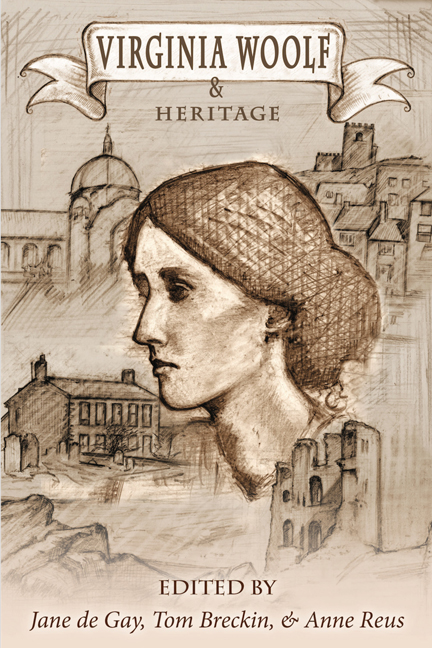Book contents
- Frontmatter
- Contents
- Introduction
- List of Abbreviations
- HERITAGE: A DEBATE
- HERITAGE, EDUCATION, AND MENTORING
- HERITAGE SPACES
- LITERARY AND CULTURAL HERITAGES
- QUEER PASTS
- MODERNISM AND HERITAGE
- WRITING LIVES AND HISTORIES
- The Play of Fact and Fiction in Virginia Stephen's “The Journal of Mistress Joan Martyn”
- “Writing the history of my own times”: Virginia Woolf and the Diary
- Heritage, Legacy, and the Life-Writing of Woolf and Rhys
- Life as Legacy: Truth, Fiction, and Fidelity of Representation in Biographical Novels Featuring Virginia Woolf
- From the Author to the Icon: A Heritage of Virginia Woolf in French Biographies and Biofictions
- Flights of Archival Imagination: Woolf 's Transcendent Materiality in Contemporary “Archive Fiction”
- WOOLF'S LEGACIES
- FINALE
- Notes on Contributors
Heritage, Legacy, and the Life-Writing of Woolf and Rhys
from WRITING LIVES AND HISTORIES
- Frontmatter
- Contents
- Introduction
- List of Abbreviations
- HERITAGE: A DEBATE
- HERITAGE, EDUCATION, AND MENTORING
- HERITAGE SPACES
- LITERARY AND CULTURAL HERITAGES
- QUEER PASTS
- MODERNISM AND HERITAGE
- WRITING LIVES AND HISTORIES
- The Play of Fact and Fiction in Virginia Stephen's “The Journal of Mistress Joan Martyn”
- “Writing the history of my own times”: Virginia Woolf and the Diary
- Heritage, Legacy, and the Life-Writing of Woolf and Rhys
- Life as Legacy: Truth, Fiction, and Fidelity of Representation in Biographical Novels Featuring Virginia Woolf
- From the Author to the Icon: A Heritage of Virginia Woolf in French Biographies and Biofictions
- Flights of Archival Imagination: Woolf 's Transcendent Materiality in Contemporary “Archive Fiction”
- WOOLF'S LEGACIES
- FINALE
- Notes on Contributors
Summary
My paper considers how Virginia Woolf and Jean Rhys conceived of their heritage in their memoirs along with the effect of their life-writing upon their literary legacies. Focusing on Woolf's “A Sketch of the Past” (written in 1939– 40 and published in Moments of Being in 1976) and Rhys's Smile Please: An Unfinished Autobiography (1976), I discuss the catalysts for their autobiographical impulses and how they shaped their lives on the page. Given the vast imbalance between the number of biographies and critical books and articles on Woolf as compared to Rhys, I also reflect on whether “Sketch” and Smile Please might be said to play a role in each writer's legacy. To what degree does their life-writing determine their status within the academy and popular culture? Does a certain kind of life-writing provide greater fodder than another for biography and literary criticism? I believe “A Sketch of the Past” and Smile Please can help us understand not only the life of each woman but her afterlife as well.
To begin, we can consider each woman's purpose in embarking upon life-writing. Cosslett, Lury, and Summerfield state that “the compulsion to tell stories about ourselves is best understood as an inner urge or an external requirement” (1). We see both dynamics at play in “A Sketch of the Past” and Smile Please. Woolf began writing her memoir at the suggestion of her sister, Vanessa Bell. Both were members of the Memoir Club, founded in 1920, in which, Mark Hussey explains, “members were supposed to read autobiographical papers that were written without research and to be completely honest” (158). The Club also included Woolf 's husband, Leonard, and several life-long friends. Thus we see Woolf 's impetus to write her life stemming from those closest to her, with the ensuing memoir engaging in deep introspection as she strives to understand herself and her writing practice more fully.
Jean Rhys's experience with life-writing displays an altogether different sensibility, for her goal was to set the record straight about her life. As Diana Athill writes in her Foreword to Smile Please, “the idea [of writing an autobiography] did not attract [Rhys] but because she was sometimes angered and hurt by what other people wrote about her she wanted to get the facts down” (5).
- Type
- Chapter
- Information
- Virginia Woolf and Heritage , pp. 202 - 207Publisher: Liverpool University PressPrint publication year: 2017



